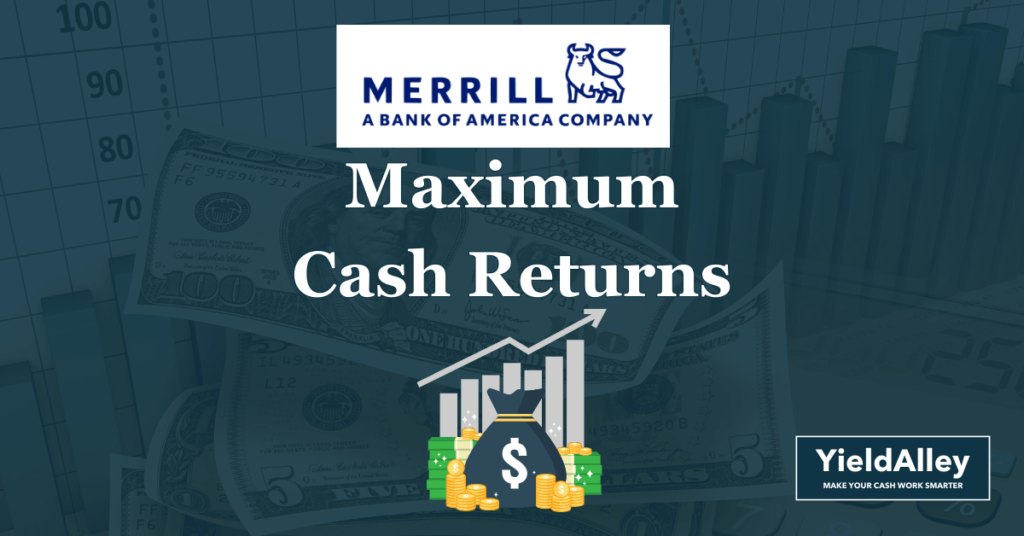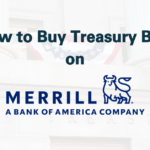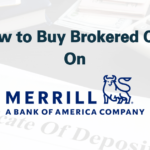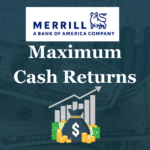Uninvested cash in a Merrill Edge or Merrill Lynch account can yield substantial returns through investments on the Merrill Edge platform. These investments will enable you to achieve more than a 5% annual return on your cash, which is far more than what you’d make from a typical bank savings or checking account. Investing your cash for additional returns on Merrill Edge is straightforward, almost without risk, and offers high liquidity.
Bank of America owns Merrill Edge and Merrill Lynch, and it’s extremely easy to move your cash from BofA to a Merrill Edge account to maximize your cash returns. In this article, we’ll walk you through the basic to most advanced ways to do this. We’ll first introduce money market funds on Merrill Edge, move on to Treasury bills and brokered CDs, and conclude with insights on money market ETFs, also known as ultra short-term bond ETFs.
Merrill Edge Money Market Funds
Merrill Edge and Merrill Lynch offer several money market funds from a variety of fund managers. Merrill, unlike its brokerage peers, does not manage its own mutual funds. The funds Merrill offers are managed by fund managers such as BlackRock, Federated Hermes, and Fidelity. Unlike its brokerage peers Vanguard, Fidelity, and Charles Schwab, Merrill Edge does not have its own mutual funds.
Merrill Edge offers money market funds across three categories:
- Government & Treasury money market funds
- Municipal money market funds
- Prime money market funds
The vast majority of the money market funds offered by Merrill Edge and Merrill Lynch are government & Treasury money market funds.
As a result, we’ll spend most of the article discussing the government funds on Merrill’s platform. Municipal funds are tax-exempt at the federal level, and any state-level benefits will depend on where you live. Prime money market funds will also invest in corporate debt securities and are riskier than government funds. At current rates, we believe the risk-reward is much more attractive by investing in the government funds on Merrill’s platform.
Government Money Market Fund
Government and Treasury money market funds invest in U.S. Treasury bills and U.S. government-backed securities such as agency bonds. Because Treasury bills are directly backed by the U.S. government, these government money market funds are considered some of the investments in the world.
Merrill offers a variety of funds in this category from three primary fund managers.
- BlackRock (TFFXX, TFDXX, TSTXX, TTTXX)
- Federated Hermes (GOTXX, GOIXX, TOIXX, UTIXX)
- Fidelity (FRGXX, FRBXX, FRSXX)
Merrill’s government money market funds are all “institutional class” funds that generally require an extremely high minimum investment. As an example, purchasing FRGXX on Fidelity’s platform would require a minimum investment of $10,000,000. However, the minimum investment is lowered to $1,000 when we buy on Merrill, which means we get the same benefits and yields that an institutional investor would with a much smaller investment.
How do we compare the various funds? BlackRock, Federated Hermes, and Fidelity are all highly reputable fund managers, so reputation and safety are not core differentiators. We typically look at yields, expense ratios (which are captured in the net yields), year-to-date returns, and any tax benefits.
The funds we keep an eye on are TTTXX (BlackRock Liquidity Funds: Treasury Trust – Institutional Class) and TOIXX (Federated Hermes Treasury Obligations Fund – Institutional Class). They both offer similarly high yields but with a large state tax exemption, 96% and 100% respectively.
These two funds would be our top choices today.
Prime Money Market Fund
Merrill Edge also offers a variety of prime money market funds, which invest in assets such as short-term corporate debt in addition to the super low-risk investments that a government money market fund will hold.
The two most popular prime money market funds to consider would be TMCXX (BlackRock Liquidity Funds: TempCash Fund – Institutional Class) and PVOXX (Federated Hermes Institutional Prime Value Obligations Fund – Institutional Class). They both offer much higher yields than the government funds and have similar expense ratios: 0.18% for TMCXX and 0.20% for PVOXX.
Both of these funds may have a redemption gate. While extremely rare, a redemption gate means the fund may temporarily suspend withdrawals. This generally only happens in the case of a financial crisis, such as the 2008 Global Financial Crisis. Even at the beginning of the Covid-19 pandemic in March 2020 with extremely high market volatility, the redemption gates did not kick in. However, we call this out since we are treating these prime funds as cash equivalents.
Merrill Money Market Funds vs. Fidelity Money Market Funds and Other Brokerages
With Merrill money market funds, you’ll get access to institutional funds that ordinarily have an extremely high minimum investment. On Merrill’s platform, you can invest in these funds for as low as $1,000.
Generally speaking, the main difference between an institutional fund and a retail fund is that institutional funds charge lower expense ratios. Expense ratios are reflected in the 7-day SEC yield that each fund reports, so comparing 7-day SEC yields is the best apples-to-apples comparison.
As a result, if you notice a money market fund on Vanguard or Fidelity with similar yields as a Merrill money market fund, there’s no reason to think that the “institutional fund” on Merrill will provide any additional benefits.
Our biggest gripe with Merrill Edge’s platform is the lack of any sweep features, which are available on Fidelity and Vanguard. This means each purchase or sale of a money market fund on Merrill requires you to manually buy or sell. This means any of your money market fund holdings won’t be treated as cash and auto-liquidated (instant settlement) when you want to withdraw cash or buy another investment.
That being said, Bank of America owns Merrill Lynch and there are multiple synergies and benefits to this relationship. If Bank of America is your preferred bank and credit card issuer because of their Preferred Rewards program, transferring cash between your BoA and Merrill account is frictionless.
Our Opinion on Merrill Money Market Funds
Here is a table comparing the different Merrill money market funds for both government and prime funds.
Best viewed on the desktop for a full comparison. Data as of January 2024.
Here’s our opinion on Merrill money market funds if you want to keep things simple: We like TTTXX (BlackRock Liquidity Funds: Treasury Trust – Institutional Class) and TOIXX (Federated Hermes Treasury Obligations Fund – Institutional Class) for the simple reason that they’re both extremely safe government money market funds but still have yields that rival prime money market funds. In addition, they benefit from a large state tax exemption.
To learn more about Merrill money market funds, check out the following article:
Treasury Bills on Merrill
We can also buy Treasury bills, which the money market funds hold a lot of, ourselves directly on Merrill Edge and Merrill Lynch.
Treasury bills (also known as T-Bills) are U.S. Treasuries with a maturity of less than one year. Currently, the highest T-Bill yield is 5.34% on a 3-month maturity, and the lowest is 4.18% on a 5-year maturity.
Why would we want to buy a T-Bill ourselves? The main reasons are when the T-Bill yields are higher than money market fund yields, guaranteed state tax exemption, and avoiding the money market fund expense ratios.
In our opinion, if you asked us to choose between a T-Bill versus a Merrill money market fund, we would just stick with the money market funds. The primary reason is that we can only buy secondary, not new-issue, T-Bills on Merrill’s online platform. You can call Merrill to purchase new-issue T-bille, but unless the yield on a T-Bill is much higher than a money market’s, we don’t recommend the hassle.
However, in the last year, there were moments when the T-Bill yields were significantly higher than rates offered by Merrill money market funds. In those cases, it’s worth buying T-Bills directly ourselves. You can read our “How to Buy Treasury Bills On Merrill Edge” guide to learn the step-by-step process of how to do this on Merrill from start to finish.
To learn more about Treasury bills on Merrill, check out the following articles:
Bank CDs on Merrill (or Brokered CDs)
The third route for higher cash returns is to buy bank CDs on Merrill Edge, also known as brokered CDs. Brokered CDs are just bank CDs you buy on a brokerage like Merrill Edge. Merrill brokered CDs offer higher yields than normal bank CDs because Merrill negotiates with the banks that are issuing the CDs to offer Merrill customers a better CD rate.
The highest yield for a Merrill brokered CD with a maturity of one year or less is 5.50%. That’s the highest CD rate that Merrill offers across all its maturities.
Meanwhile, the only way to even get a CD rate of over 4% at Bank of America is to lock up your money for at least 13 months, with an opening deposit of at least $10,000. Even withdrawing early means paying an early withdrawal penalty.
Be aware of two things when buying a brokered CD:
- These CD rates are guaranteed only if held to maturity. However, some brokered CDs are callable, which means the bank issuing the CD can recall them early. This is typically done when rates go down, so the banks won’t have to pay a higher interest rate. To prevent this, buy a non-callable CD to be able to hold the CD to maturity.
- Brokered CDs are liquid, meaning you can sell them on Merrill’s secondary marketplace before they mature. But the secondary CD marketplace isn’t always super active, so you might not get the price you want to sell your CD at. Regardless, brokered CDs are still better and more liquid than regular bank CDs that force you to pay an early withdrawal penalty.
To learn more about Merrill brokered CDs, check out the following articles:
- What are Brokered CDs?
- Merrill Edge CD Rates
- How to Buy CDs on Merrill Edge
- Bank CDs vs. Brokered CDs
- Bank Hopping For the Best CD Rates
Ultra Short-Term Bond ETFs (Money Market ETFs) on Fidelity
The last method to earn higher cash returns on Merrill is to buy money market ETFs. Also known as ultra short-term bond ETFs, these investments are newer and thus more unknown and underappreciated compared to the previous investments we mentioned.
There are two main types of ultra short-term bond ETFs:
- Treasury ETF
- Floating rate Treasury ETF
Treasury ETFs hold very short-term Treasury bills, just like Treasury-only money market funds.
The most popular ultra short-term Treasury bond ETF is SGOV (iShares 0-3 Month Treasury Bond ETF). SGOV was introduced in 2020 and holds T-Bills with a maturity of 3 months or less. SGOV currently has a yield of 5.40% with a 2023 return of 5.12%.
Floating rate Treasury ETFs, on the other hand, hold Treasury floating rate notes that always reflect the latest 3-month T-bill rate, which resets every week. In simple terms, you are always getting the most up-to-date 3-month T-Bill rate by holding these ETFs. As interest rates rise, floating rate Treasury ETFs pay higher interest payments. If rates fall, the payments decrease.
The most popular floating rate Treasury ETFs are USFR (WisdomTree Floating Rate Treasury Fund) and TFLO (iShares Treasury Floating Rate Bond ETF). USFR has a yield of 5.42% and a 2023 return of 5.18%, while TFLO has a yield of 5.39% and a 2023 return of 5.17%.
Ultra short-term bond ETFs are our preferred holdings for our cash. They have higher yields than Merrill money market funds, are easier to buy than T-Bills, and are more liquid than brokered CDs.
ETFs, including ultra short-term bond ETFs, usually have a settlement period of two business days (referenced as T+2), which means cash will be available in your account two days after you sell. So it’s still extremely liquid, but you won’t have access to your cash instantly. In most cases, this is just fine for us.
To learn more about ultra short-term ETFs, check out the following articles:
Comparing Our Cash Returns Options on Merrill
We’ve now reviewed the main types of investments to consider for higher cash returns on Merrill: money market funds, Treasury bills, CDs, and ETFs.
To compare your options on Merrill, we put together the table below that compares each investment’s yield, fees and costs, minimum investments, “sweep” features, and tax benefits if any.
Best viewed on the desktop for a full comparison. Data as of January 2024.
If you have a Merrill account, it’s wise to move any cash from your Bank of America account or other bank accounts to your Merrill account.
You can take matters into your own hands and earn more yield while still staying liquid. We have a preference for the floating rate ETFs as they earn you the most updated 13-month T-Bill rate every week.
Don’t let your cash sit idle. It can be put to work and earn you virtually risk-free money, and significant returns in today’s market. Move your cash from your bank to Merrill (or any other brokerage that you use) and start earning yield!






